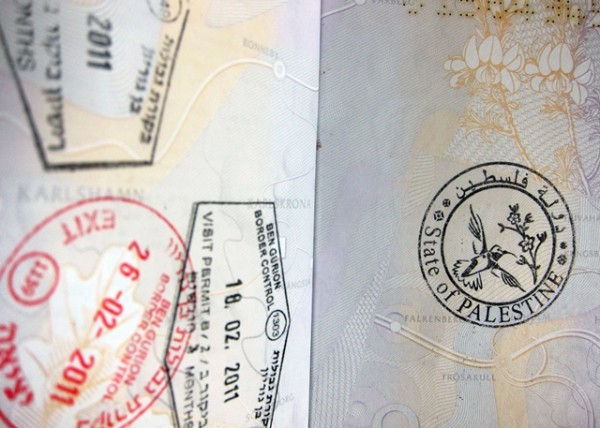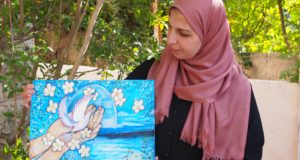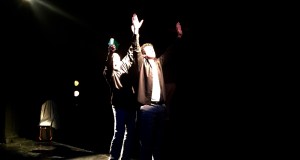by Alistair George
21 November 2011 | International Solidarity Movement, West Bank
Khaled Jarrar is a Palestinian artist and photographer from Jenin, currently based in Ramallah. In addition to photographing and documenting the Israeli occupation, he has designed a ‘State of Palestine’ postage and passport stamp. This week in an interview with Alistair George of International Solidarity Movement, Jarrar explains the idea behind his stamp, past and future plans, and the extent to which art influences political resistance.
ISM: What’s the idea behind the ‘State of Palestine’ passport stamp?
Jarrar: I had my idea three years ago. I was with my international friends and they told me about the hard time they get at Ben Gurion airport [in Tel Aviv] when they want to visit Palestine, and especially if they tell the border police that they are going to the Palestinian territories. So I was thinking – how come the Israelis decide who is welcome in our country? We would like to welcome everybody! So I said that I would make a ‘Green Card’ for my friends; a kind of ironic permit which says they can live and work inPalestine. It sends the message that we have the right to say ‘you are welcome toPalestine’. People came to a gallery in Ramallah where they filled in the ‘applications’ and got a ‘permanent resident card! They took it as a souvenir.
Ten months ago I was trying to re-think and develop the project. I worked on the design for [‘State of Palestine’] postage and passports stamps. I was trying to make something beautiful, something that would fit with my ideas about humanity and not just an olive tree or a mosque – something more human than ideology or politics. I found this bird – it’s called the Palestine Sunbird. I heard a story that the Israelis tried to change the name of the bird to make it their national bird. It’s a beautiful bird and I used a jasmine flower, because it is beautiful. The Israelis actually used the bird on the design of an Israeli postage stamp in 1963, even though they wrote ‘Palestine Sunbird’ on it, which was quite ironic and paradoxical to me.
I made the design, and I was worried that it would be another project that would happen and then disappear. I needed to give a life for this stamp, and I thought it should be in the official place for stamps – a passport. Then I started to ask my friends if I could stamp their passports, but they said, “Are you crazy?’ I said, “But they only have stamps for Israel, why not for Palestine– you were in Palestine!”
The stereotype here is conflict, conflict, conflict and I want to show something beyond this, I want to show life. I started to ask people, and I could not find anybody who dared do it – then I found a French girl. She was sitting in a bar, and she gave me her passport. It was the first stamp. I started going and doing the performance [stamping passports] at Ramallah bus station and Qalandia checkpoint, and I found that people would like to do it but that I need to search for the right people. I’ve now also got t-shirts, bags, mugs [with the design].
ISM: How many passports have you stamped and what has the reaction been?
Jarrar: I’ve stamped around 180 passports. I’ve taken the emails for nearly all the people whose passports I’ve stamped, and I keep in touch with them. I did the performance in Ramallah several times, and for two days at Checkpoint Charlie in Berlin, and also twice in Paris– once at the Pompidou. Many people like it and find it very beautiful. But there are many people who are afraid. But this is an art project.
OK it has a strong political statement about our resistance as a human beings, not only as Palestinians. The Israelis don’t want to treat Palestinians as humans or as a nation. We are not defined as a nation by the whole world, we are undefinable – it’s like we don’t exist or we are called ‘stateless.’
Slavoj Zizek [a Slovenian philosopher] got his passport stamped in Ramallah. One guy came to him and said ‘Slavoj, don’t do it – it’s dangerous – the Israelis will arrest you!’ But he said ‘F— it, do it, do it!’ and so I stamped his passport.
ISM: How have the Israeli authorities reacted to the stamp?
Jarrar: Some people have been interrogated, but for many people the authorities didn’t even mention it. There was one guy from South Africa [who got his passport stamped], his name is Eddie – he was the first one to leave with the stamp. The Israeli border police saw the stamp and were shocked, they said, ‘This is the first time I’ve seen something like this.’ They stamped his exit visa, gave him back the passport and he left! They didn’t interrogate him at all.
The second one, from Denmark, who left with the stamp – when the border police saw it, they called someone, who called another person, and five people looked at the stamp. They didn’t say a word, just made a photocopy and then gave him the passport back and he left.
I think at the beginning the Israelis weren’t sure if this was real or art, but of course there are some bad stories that happened for some people who were interrogated and stopped. There was one girl from Holland who was stopped by the Israelis. They said ‘we are not used to seeing something like this, it is illegal.’ She said ‘no it’s not, it’s an art project, and from now on you will see many of these stamps!’ The officer interrogated her, asking ‘Why did you do this?’ and ‘Who did this for you?’ They kept her for one hour, they took her hard disk, they did a strip search and opened her luggage.
I didn’t hear officially from somebody who has been denied entry because of the stamp. But there are many stories. There is one American girl who had the stamp – she wanted to apply for work permission in Jerusalem. She had the invitation and all the paperwork. The Israeli Ministry of the Interior looked at her passport and they said – ‘you can’t apply for permission for a visa in Israel because you have this stamp in this passport. Maybe you can just remove the paper.’ So she ripped it out of her American passport, she reapplied and she got permission for one year visa to work here!
There was one girl who got the stamp, she was born in the United States and had an American passport. In 2008 she applied for the Jewish ‘right to return.’ She got an Israeli passport within 2 years. I stamped her American and Israeli passports [with the State of Palestine stamp]. She left but when she came back to Israel they asked her ‘What is this?’ She said ‘A Palestinian State stamp.’ When they said that ‘this does not exist,’ she said ‘the state of Palestine existed before the state of Israel.’ They interrogated her for an hour and they cancelled her Israeli passport. She applied for a new passport and she said that she is waiting to see if she can get a new one.”
ISM: Is the State of Palestine stamp referring to one state or is it an endorsement of the two state solution?
Jarrar: It is for a one state solution. It is a demonstration against occupation and against the partition of Palestine. I am really against the two state solution. We need to remove hate, partition and division because this is what our politicians and Israeli politicians want, so they can control us. If we have one state, the people will rule the state.
ISM: So you don’t support the Palestinian Authority’s bid at the UN for Palestinian statehood?
Jarrar: I’m not with this. The United Nations are the ones that partitioned Palestinein 1947 – why go to the one who is hitting you to ask for his mercy?
ISM: You’ve also designed postage stamps?
Jarrar: I have a gallery in Paris and my gallery asked the post office there to print these postage stamps and they refused. We found a printers that likes to do political stuff and they printed them. I exhibited them at an art fair in France.
We used to sell this postage stamp with an actual price – 750 fils, which is the old Palestinian currency, around 75 cents. So at this art fair there was a lot of expensive artworks there – like some that cost over 2 million Euros and my stamps cost 75 cents, so they compared them and made a lot of promotions for us so a lot of people came to buy the stamp – it was fantastic.
I asked people to use them on actual letters, you can use them next to the official stamp and see what will happen. I don’t know yet exactly what will happen, if they will reject it, if it will arrive or not – I’m waiting for people to tell me if they have arrived.
Everything is controlled by the Israelis. If you send a letter from England to me in Ramallah, maybe it will take 6 weeks. My gallery [in France] sent me the postcards for the fair two months ago and I haven’t received them. Maybe the Israelis didn’t let them pass and they threw them away. I’ve been to Paris, been to the art fair, but the invitations didn’t arrive yet!
ISM: Can you talk about some of your other work as an artist?
Jarrar: I am also a photographer – I staged an exhibition called ‘At the Checkpoint’. I took photographs at the checkpoints in 2006 and in 2007, and I exhibited them at the Israeli checkpoint, where the Israeli soldiers themselves could see them. Some were very angry, they didn’t know what to do. It was provocative but at the same time it was very peaceful. One soldier spotted himself in the picture and he was very happy to be in an exhibition!
An officer came with four soldiers – he ordered them to remove the photos [from the fence at the checkpoint] and arrest the organizer. But I had invited foreigners, Israelis, the press and this was protection for the exhibition. One woman from Machsom Watch went to the officer and said, ‘Look, this is not a demonstration, this is just an exhibition.’ We told him we would leave in two hours so they left us alone and it was OK. I did it twice, once at Huwara checkpoint and once at Qalandia.
I am hoping to do a book about my projects with Simon [Faulker, an academic at Manchester Metropolitan University].
I also did an exhibition and project about people who are using sewage tunnels to sneak to the other side in Jerusalem [from the West Bank] to visit their families and for social, economic, and religious reasons.
I made a video about it called Journey 110, and I’m making a long documentary because I was observing the whole process of sneaking to Jerusalem for four years. Now the tunnel is closed but when it was open I used to see 500-600 people use it in three hours. But there’re not only tunnels, there are other ways [to reach Jerusalem].
Journalists are there to document it and smugglers also try to play their games and make money. Sometimes they pay money but they find on their journey that the tunnels are closed, or the walls are too high, or there are Israeli soldiers. It’s really challenging – they are trying to live and survive and this wall will not stop anything. So with this issue I’m really destroying the idea that this wall is for security reasons. So many people manage to enter Jerusalem and none of them are suicide bombers, they are people looking for life. It’s not just about Palestine and Israel, it’s also about really basic issues – the need for life. It should be finished in April 2012, I have struggled to find the money.
ISM: Have you any future plans for the ‘State of Palestine’ project?
Jarrar: I have been invited to the Berlin Biennale and hopefully I will print some more postage stamps – I have a new version with Hebrew, as well as Arabic and English. I was having a conversation with a girl fromNew York, she said ‘you know that there were Jews living in Palestine before the occupation and they were Palestinian?’ I said of course and this was a mistake [not to include Hebrew] so I’ve fixed this mistake.
My work is being exhibited in London for a group show, starting on 23 November [‘Passport to Palestine at La Scatola gallery]. But I’m not going – they invited me really late and it is difficult to apply for a visa to theUK, you need a lot of time and I tried to apply twice before and I was refused because of the bureaucracy. I will send a stamp and someone will be an ambassador for the ‘State of Palestine’ who will be stamping the passports. There are other events [to stamp passports] in Copenhagen on 29 November. In Brussels there is a magazine [A Prior magazine] event so I will be stamping passports and magazines there on the 25 November.
ISM: What impact has the project to stamp passports had?
Jarrar: I’m not sure exactly. I’m trying to create a new reality and a new way of resisting occupation. Maybe this will raise awareness for other artists in the world, showing them how they can use new ways of resistance for freedom and equality and humanity all over the world, not only in Palestine.
ISM: This reminds me of Juliano Mer-Khamis’s [former director of Jenin’s Freedom Theatre] idea of a ‘Cultural Intifada’. Do you see your work in this way and to what extent do you think art can influence political reality?
Jarrar: Yes I do. I believe that art can create reality. I don’t believe in this kind of art that tries to separate itself from politics and reality – they can’t be separated. So politicians try to control our lives so we should be responsible [as artists] and fight and to express our feelings; not only to talk and make exhibitions in the gallery where just a few people can come and say ‘oh this is beautiful’ and after that you can throw it in the garbage. So I think art should make a difference and we should use art to send our message loudly to shake and provoke the system and to say to the politicians ‘stop – where are you taking us?’.
Alistair George is a volunter with ISM (name has been changed).
 International Solidarity Movement Nonviolence. Justice. Freedom.
International Solidarity Movement Nonviolence. Justice. Freedom.


